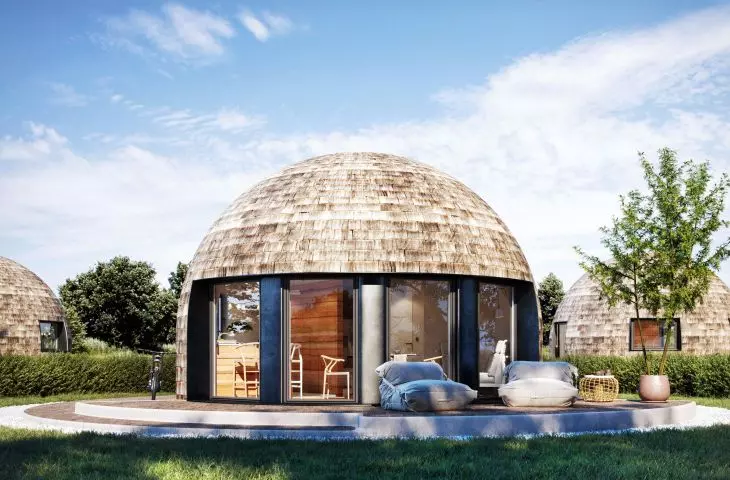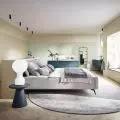Prefabrication, modular construction and eco-friendly technologies are gaining popularity. Pawel Fornalski, owner of the Domir studio, together with architect Tomasz Macalik, combined all of these elements and reached for natural materials to create hempcrete modular dome houses, which are increasingly popular among individual investors. We talk to the authors of the residential domes about alternative and natural technologies, the advantages of hempcrete and the future of construction.
Domir has two types of prefabricated residential domes in its product range, with a choice between a smaller module with a construction area of 35 square meters with a mezzanine floor and a two-story module of 100 square meters. They are united by a centrally located skylight and natural construction technology—they are created from wood-framed modules filled with hemp concrete and wood wool. The facades of the domes can be covered with tiles or aspen shingles, and the interiors with clay plaster. How did their project come about? We invite you to read an interview with the originators.
larger dome house,
segments: 1. construction in C24 wood, 2. infill modules, 3. steel fixings
© Domir
conversation with Tomasz Macalik and Paweł Fornalski
Dobrawa Bies: How did your history with designing dome houses begin? What was the beginning and what did the first projects look like?
Tomasz Macalik: In design, we pay more and more attention to natural solutions. Of course, everyone has a different definition of natural or green building. One of its elements could be the use of materials for construction that use as little energy as possible to produce, that are minimally processed, preferably local, with low environmental impact. But material is only one aspect. Attention must also be paid to the broader issues of building physics. The search for suitable solutions led to a meeting with Pawel Fornalski, who asked me to design modular dome houses.
Previously, Domir produced domes made on-site by spraying method
© Domir
It was necessary to study the design and implementation of dome houses, or houses based on a circular plan. Already at the stage of the first concepts we tried to create the possibility for future residents to arrange the interior quite freely, hence the decision to build from modules. Then we analyzed the production possibilities and adjusted the design of the structure. And so, using our joint expertise—Paul's in the construction of domes, the use of hemp concrete or clay plasters, and mine—in design, modular residential domes were created.
Dome house built on site, aspen shingle facade
© Domir
Dobrawa: The buildings proposed by Domir are modular and made of hemp concrete, among other materials. How do you go about working on them—from design to construction?
Tomasz: We started the design of the dome houses by adopting a module that would restrict future residents as little as possible in terms of interior design, while at the same time allowing for production and later installation. The concept is quite simple—modules are prefabricated in a covered hall, under controlled conditions, then transported and assembled on site. This way, from the customer's point of view, significantly reduces construction time. From our side, it facilitates production, allowing greater control over the finished product and, consequently, higher quality.
The smaller dome has an area of 35 square meters
© Domir
We make the structure of the modules from C24 wood, cutting the components of the modules on a CNC router, then we join these components into modules in the form of spatial trapezoids, which are the components of the dome. The next stage of the work is to fill the modules with wood wool or hemp concrete—here we use our proprietary method of hemp concrete application. Modules made in this way must dry—we wait until the process of hardening of hemp concrete, i.e. lime setting, takes place and we get 30% humidity. Hemp concrete, used as a filling, in its composition has a hydraulic binder—lime, which requires time to fully set. Thanks to the possibility of drying the modules at the plant, under a roof, the customer does not have to worry about the seasoning stage and practically proceed with further construction work immediately after the installation of the modules.
HEMPCRETE DOMIR hemp concrete has received the National Technical Assessment
© Domir
Dobrawa: You mentioned hemp concrete, how do you describe this material in a few sentences? How do you convince skeptics of it?
Pawel Fornalski: Hemp concrete(hempcrete) is a lime and hemp composite—it consists of cut pieces of industrialhemp stalk(hemp shive) mixed with a binder based on a lime mixture of building lime and hydraulic lime. It provides a natural, healthy, sustainable, local building material with low embedded energy. I would like to add that we are the only ones in Poland to have obtained a National Technical Assessment and received the „B” construction mark for the thermal insulation material—hemp concrete under the name HEMPCRETE DOMIR, which allows us to use this material in public buildings. At a time when energy costs a lot, very good thermal insulation properties are important, and this is what hemp concrete has, so it is no longer necessary to use additional thermal insulation. The thermal conductivity coefficient is λ=0.066 W/m*K. It is worth adding that the lime contained in hemp concrete is an antiseptic material. High vapor-permeability allows the walls to breathe, which protects against dampness in the rooms. In turn, hemp concrete itself regulates the temperature and humidity in the house, providing an optimal microclimate.
The larger residential dome consists of two levels
© Domir
Dobrawa: The buildings proposed by Domir are made on a circular plan, hence their interiors are unusual, and the walls do not have right angles. How do you arrange such rooms and adapt the furniture to them?
Paul and Thomas: In most cases, furniture can be arranged typically, against partition walls, however, it is worth adjusting, for example, the kitchen countertop to the shape of the building. Guidance can be provided by interior designs made on the visualizations we offer. Another important step is to plan functional zones. When there are no right angles, it is necessary to properly lay out the space, allowing free movement inside the rooms. A good solution is furniture that separates zones, such as shelves, bookcases or screens. In the living area in the dome houses, we created an open space so as not to limit the possibilities of adaptation. In conclusion, interior design in circular buildings requires a little more creativity and flexibility, but with the right approach it is possible to create interiors that meet our requirements.
In domes, functional interior planning is important
© Domir
Dobrawa: Who are the users of dome houses. Who in particular are you targeting with your offer?
Paul: Domed houses are a construction solution that is attracting the attention of people looking for innovative and ecological alternatives. Users of such houses are usually people interested in their own health and internal, broad-based development. Practitioners who value frugality and can manage their capital appreciate a house with less energy consumption for heating and cooling than a typical building. Another group of dome home users are artists and creatives who are looking for original housing solutions that inspire their work. The final group of people who opt for dome homes are those who are looking for a place of peace and tranquility. The shape of the dome and the peculiarities of construction are conducive to meditation and relaxation, making such a dwelling an ideal retreat for those in need of respite from the hustle and bustle of everyday life.
Dome houses can create an alternative settlement
© Domir
Dobrawa: How do you see the future of construction?
Paul: In our view, the future of construction will be based on a sustainable approach that prioritizes protecting the environment and providing the best possible living conditions for people. One of the key aspects of this approach will be the use of materials with high thermal insulation parameters and low energy consumption during production. Such materials will provide excellent thermal insulation, which will help reduce energy losses in buildings, and consequently also reduce operating costs. Moreover, these materials should be locally available to minimize the negative impact of transportation on the environment. An important aspect of sustainable construction will also be the use of materials that can be recycled or composted after use. This will minimize the amount of waste that ends up in landfills.
Pawel Fornalski against a background of hemp concrete
© Domir
Of course, the modular form of the building is another key element of the future of construction. By using, prefabricated modules, the building process will be much faster and efficient. In addition, modularity allows easy modification and expansion, which is very important in the context of changing user needs and rapidly developing technology. In the face of increasing disasters caused by climate change, the dome form is becoming an increasingly attractive building solution. We believe that with their ability to withstand high winds and hurricanes, dome homes provide effective protection against extreme weather conditions, and are therefore gaining popularity as a way to increase safety and resilience to natural disasters.
Dobrawa: Thank you for the interview.
Another proposal for a dome house is a monolithic foam concrete building by Mitra Tech studio, which you can read about in the article Dome house made of foam concrete.
































































































